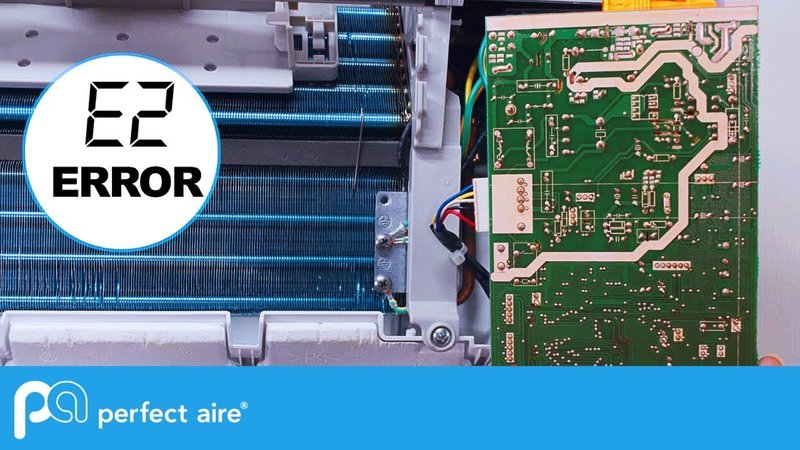
Think of your air conditioner as a well-oiled machine—normally, it hums along, keeping your space cool and comfortable. When it throws an error code like E2, it’s much like a car’s check engine light. It’s signaling that something needs your attention. Specifically, the E2 error code often relates to an issue with the unit’s internal temperature sensor. This sensor is like a thermostat for the air conditioner itself, monitoring the interior temperature and ensuring everything works within safe limits. When it doesn’t, it’s like a friend trying to tell you, “Hey, something’s off here.”
Understanding the E2 Error Code
You might be wondering, “Why is this happening?” Well, the E2 error code typically indicates that the air conditioner’s internal temperature sensor has malfunctioned or is reading a temperature that’s outside of the normal range. Essentially, this sensor checks if the air within the unit is at the right temperature. If the sensor fails to register the correct temperature, or if something blocks its ability to measure accurately, the whole system can get thrown off.
Imagine trying to cook something without a proper thermometer. You’d be guessing at the temperature, right? In a similar way, without the sensor functioning correctly, the air conditioner can’t do its job. This can lead to inefficiencies and, in some cases, might even cause the unit to stop working to prevent damage.
A malfunctioning sensor might sound daunting, but fixing it can often be straightforward. In many cases, this involves checking for loose connections or ensuring the sensor is clean and unobstructed. Sometimes, it’s just a matter of resetting the unit, allowing it to recalibrate and try again. Yet, just like when you’re not quite sure about a problem with your car, if these basic steps don’t solve the issue, it might be time to call in a professional.
Potential Causes of the E2 Error Code
So, what can trigger this error code in the first place? There are a few potential culprits. First, a common issue is a loose or faulty connection. Over time, the electrical connections that link the sensor to the main control board can become loose or corroded. This disruption can cause false readings or no readings at all.
Another possibility is a dirty or clogged sensor. If dust and grime accumulate on the sensor, it might not be able to read the temperature correctly. Think of it as trying to look through a fogged-up window—a clean slate can make all the difference.
Finally, the sensor itself might be damaged or defective. Electronics can fail over time, and sometimes parts just give out. If the sensor is broken, it may need to be replaced. This isn’t something you’d necessarily need to tackle on your own, especially if you’re not comfortable with DIY repairs.
Steps to Resolve the Error Code
Here’s the deal: fixing the E2 error code could be as simple as resetting your air conditioner. Start by turning off the unit and unplugging it from the power source. Leave it unplugged for a few minutes to allow the internal circuits to fully power down. Then, plug it back in and turn it on again. This process often resets the sensor and can clear the error code.
If that doesn’t work, take a closer look at the sensor and its connections. Locate the sensor inside the unit—consult your model’s manual if you’re not sure where it is. Check to see if any wires are loose and gently push them to ensure they are snug in their connectors. If you notice any dust or dirt on the sensor, clean it carefully with a soft cloth. This step is much like changing a light bulb or tightening a screw—a small fix that can restore functionality.
Should these steps not get your air conditioner back on track, it could be time to reach out to a professional technician. They can diagnose more complex issues and perform repairs safely and effectively.
Preventing Future Occurrences
Once you’ve resolved the E2 error, it’s a good idea to take some preventative measures to avoid seeing it again. Regular maintenance is key. Think of it like taking your car for regular oil changes—keeping your air conditioner clean and well-maintained can help prevent many common issues, including sensor malfunctions.
Ensure your unit isn’t operating in excessively dusty or humid conditions, as these can contribute to sensor issues. Periodically check all connections and components for signs of wear or damage, and take care to clean dust and debris from the unit’s interior.
Finally, consider scheduling annual service check-ups with a professional technician. These visits are like wellness check-ups for your appliance, catching small issues before they become major problems. By being proactive, you can extend the life of your air conditioner and keep it running smoothly all summer long.
In conclusion, while an E2 error code on your GE air conditioner can seem intimidating at first, a little knowledge goes a long way. By understanding the potential causes and knowing how to address them, you can often resolve the issue quickly and get back to enjoying your cool, comfortable space.